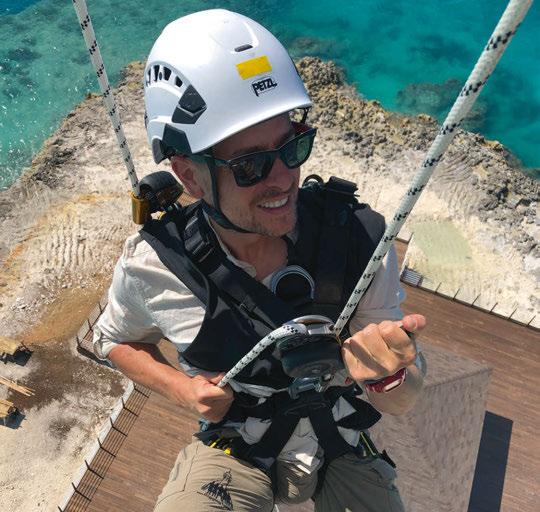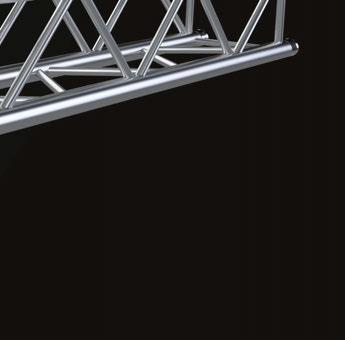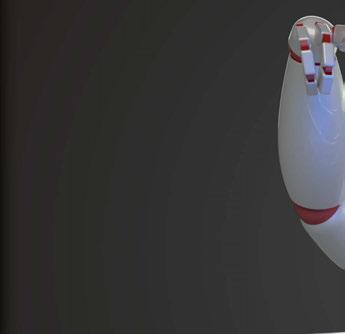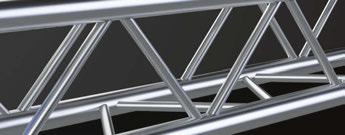
9 minute read
THE LIGHTHOUSE The Bahamas
from MONDO-DR 31.3
THE LIGHTHOUSE
OCEAN CAY MSC MARINE RESERVE / THE BAHAMAS
Located on the paradisiacal Ocean Cay MSC Marine Reserve, The Lighthouse features a custom-designed light show that tells the story of Marine Reserve and MSC’s dedication to conservation.
Below & Right: The visual show wraps around the lighthouse structure.


Ocean Cay MSC Marine Reserve is a unique, private paradise located in the Bahamas. Immersing guests in its idyllic island beauty, its white sands and transparent turquoise seas serve as a dream-like location to decamp MSC’s Cruise ships and spend the last leg of a life-changing journey. With an expectation of perfection, the multi-million pound fantasy island is one-of-a-kind, encompassing every element of the holiday experience, with live music, restaurants, bars and a landmark video, audio and lighting show from the island’s iconic lighthouse, ensuring guests will never forget their stay. Before COVID-19 struck, the island was welcoming four cruise ships per week, all of which were carrying around 4,000 guests. Arriving to a warm welcome from a team who have worked furiously to make this project a success, guests can reconnect with their natural surroundings and find peace in the relaxing atmosphere the island projects. The real star of the Ocean Cay show, though, is the island’s Lighthouse, that was a project taken on by immersive design agency, The Department. Hamish Jenkinson, Co-Founder of the company, takes up the story: “I met the technical director of MSC Cruises at an exhibition during London Design Week back in 2018. We spoke about the amazing growth of MSC and some of the ideas that he had to further enhance the cruise lines, and I mentioned how The Department could potentially help execute some of these ideas.

“I went to the company’s offices to give a presentation to the wider team, and through this I found out that the project they were most excited about was the transformation of the island. They wanted to build a multimedia lighthouse and it immediately occurred to me that we could design an LED light that would fit perfectly into the pre-existing design, instead of using projection mapping that could potentially cause problems.” After confirming the project with MSC, Hamish attended Integrated Systems Europe 2019 to seek out a proficient lighting company that would be able to craft the perfect lighting package for the project. The team needed a mesh screen to cover the lighthouse that also incorporated 14,000 LEDs, and Amsterdam based lighting manufacturer, InventDesign, was confident it could achieve this. “We are very strong in pixel-controlled LED solutions, so it was a perfect match,” explained Robin Sluis, Account Manager at InventDesign. “The main challenge was making a retro fit LED module, because the lighthouse was already designed and built with holes in the façade. Normally we would attach our LED modules on a mounting clip, so we were firstly thinking of using tie-raps or aluminium flat profiles to install all the modules, but aesthetically this was not the solution they were looking for. “Our product manager then came up with the idea of creating a custom lens with barbs, so we could press the modules through the existing holes. This meant that we needed the exact measurements of the holes. If the lenses were too big, they would not fit, too small and they would fall out. We requested a panel from them to measure it and then we 3D printed the prototype.” As every module on the lighthouse needed to be independently controlled, Invent Design implemented 14,238 of its DiGi E3S modules that contain three RGB LEDs and an IC Chip, as the IC Chip allowed the team to control the RGB LEDs with an SPI protocol. 36 DiGidot C4 live controllers were also specified, a popular choice as the Art-Net to SPI converter can achieve high frame rates, completing the perfect combination for this project. “The LED modules have a pitch of 140mm horizontally and vertically, and are retro fit in the lighthouse structure. They are powered by power supplies that are located on each elevation of the lighthouse, and the controllers are based at the bottom of the lighthouse sending data from the bottom to the top. The lighthouse is built with panels and we covered 13 panels in width and 36 in height. Every panel has five modules in height, we started with nine modules in width at the bottom, but because the panels became smaller at the top, we only installed five in width at the top.” As well as deciding on the lighting manufacturers, The Department also needed a dedicated lighting design team that was able to bring
Left & Above: The lighthouse has been built to withstand all weather conditions.


Top: Hamish Jenkinson, Co-Founder of The Department, working onsite.




its lighthouse vision to life. Design company, Woodroffe Bassett Design (WBD), have worked on some outstanding projects across the world, including Dinosaurs in the Wild and the famous Rolling Stones Exhibition in London, so Ocean Cay was a project it was excited to tackle. “We were approached by The Department to provide the lighting design for this exciting project. Patrick Woodroffe was to be the lead creative, with me acting as his Associate,” explained John Coman, Designer at WBD. “Initially, Patrick worked with Hamish on the concept development. Then, collaboration with both the composer and video designer was undertaken to ensure there was an engaging and interesting show for the audience that also provided moments for impactful lighting. “Once the ‘big’ picture was defined Patrick and I then worked out the best combination of fixtures and where these could be located. As this was a permanent install we were cognisant of logistical and technical constraints. These fixtures needed to be rigged metres from the sea, on an isolated island in a region that suffers many storms. As with all detail design there needed to be extensive collaboration with other departments and disciplines including the island architect, the landscaping architect and the island electrical engineering design team.” Since the show was being viewed from 300 metres away, the team decided on fixtures with high lumen output to make sure that every part of the show could be seen on shore. To achieve this WBD supplied 50 Light Sky Shark 450s. This particular waterproof IP66 beam light adopts an aluminium cover that is suitable for harsh environments. Its CMY colour mixing system is also smoother and more abundant. John furthered: “Cognisant of the adequate but tight lighting budget we “AS THIS WAS A PERMANENT INSTALL WE WERE COGNISANT OF LOGISTICAL AND TECHNICAL CONSTRAINTS. THESE FIXTURES NEEDED TO BE RIGGED METRES FROM THE SEA, ON AN ISOLATED ISLAND IN A REGION THAT SUFFERS MANY STORMS.”
Above: The project was a real team effort, and before the pandemic hit guests were treated to an incredible spectacle that showcased the hard-work and determination of everyone involved.

decided that we should limit the fixture product to one type. This would help enormously in getting a good ‘bulk’ buy deal from manufacturers. In the past WBD have used the Light Sky Aquabeam IP44 and found it to be extremely bright, narrow and reliable. We were intending to specify this fixture when we discovered that Light Sky had released a new IP66 light, the Shark 450. These were upgraded Aquabeams with even greater waterproofing. “Another thing to note is that each fixture received its own power and data link through a custom waterproof cable. This was done to ensure any faults, like water ingress on the data line, is isolated to a single fixture only.” WBD also called on White Light (WL) to assist with the installation, supply of kit, crew and project management. WL’s Special Projects Director, Simon Needle, commented: “It was fantastic to once again work with WBD and The Department to help deliver this unique and exciting project. As a company, we were able to draw on a variety of services that we offer and are delighted with the final outcome. We look forward to the Lighthouse being appreciated by as many guests as possible over the coming months.” “Once design detail was completed, we worked with our lighting programmers to pre-vis each of the Lighthouse shows,” said John. “Using a very detailed WYSIWYG model each show was fully programmed prior to arrival on the island. This both allowed for the sharing of WBD’s lighting ambition to other creatives and the client, and also significantly reduced the amount of programming time needed onsite. Pre-vis programming was provided by Tim Oliver, Alex Passmore and the late Jonathan Rouse. Alex joined me onsite for the final programming in reality.” The reality of Ocean Cay’s lighthouse is a spectacular amalgamation of multicoloured media creating a beam of light, video and sound that could be seen from the stars. As the lighthouse dances, so do the guests, and the incredible work of The Department, InventDesign, WBD and WL is more than fully appreciated. “As soon as we took on the job, we were welcomed into the MSC Cruise family,” said Hamish. “They wanted a 10/10 project, and I do believe everyone involved made sure we achieved that. Before the pandemic hit, the guests who got to experience the show absolutely loved it, and hopefully once we’re out the other side of the pandemic I can head back to the island and see for myself the impact it has on the guests and the overall island experience.” TECHNICAL INFORMATION
LIGHTING 14,238 x DiGi LED E3S module; 50 x Light Sky Shark 450 moving head; 36 x DiGidot C4 live controller; 1 x MA Lighting GrandMA 2 Command Wing control desk; 1 x MA Lighting GrandMA Light control desk
www.mscoceancay.com
Above: The lighthouse light show is a one-of-a-kind experience.


















